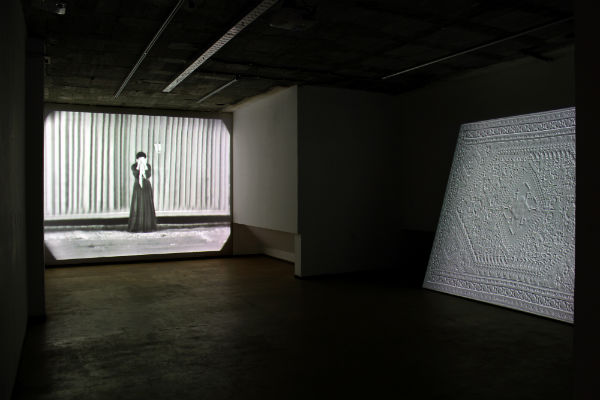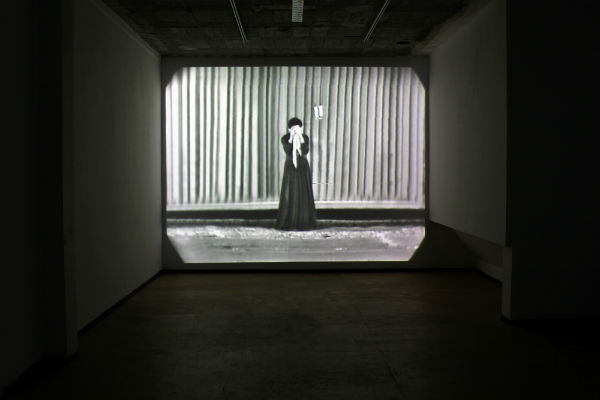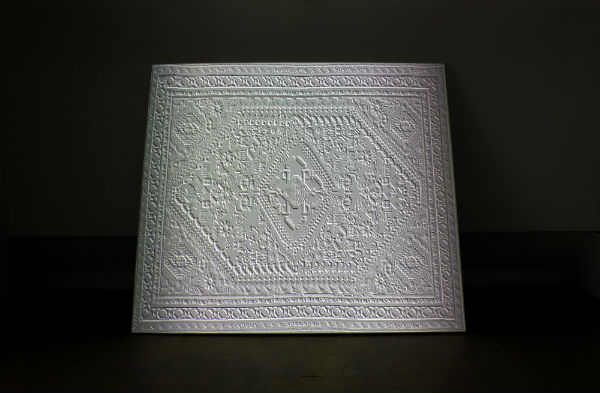Nevet Yitzhak
Sun before Sunset
Kav 16 - Community Gallery for Contemporary Art, Tel Aviv
Jan - Feb 2013
In her exhibition Sun before Sunset (1) Nevet Yizhak examines in a nostalgic but sobered view the evolution of cultural tradition, its transference and reabsorption, within a reflective reference to time dimension. Out of an abstract ununiformed syntax of tones sound samples of singing, playing and applauses, three artworks interwoven within each other visually and thematically can be seen in the gallery space.
These are digital readymade works, manipulated and deconstructed found footage, image and sound assemblages created through minor operations of cutting and pasting, editing and animation that disrupt traditional aesthetic models and create new compositions.
Following the observation and investigation of visual and musical traditions from popular and high culture as well – such as Arabic classical music or conceptual aesthetics of the oriental ornamentation, Yizhak examines the way those are delivered and transferred further on. (2)
At the same time Yitzhak manages to object them through a reformulation in a personal and original voice. In this exhibition Nevet Yizhak continues to deal with the connection between sound and visual image as raw materials which nourish each other, creating a new context between the visible and the heard and providing reading to the artistic work while focusing in the visitors experience through looking and hearing.
The work Sun before Sunset (2012) an animation screening on a standing stage leaning on one of the gallery walls is presented in the center of the space. This is a screening of a schematic model, a prototype of a Persian carpet which becomes through the digital process in to an ornamental relief decorated with stylized geometrical and floral motives, seeming for a moment as an ancient archeological remain. The animation work consciously and intentionally disrupts the familiar aesthetic course. The insertion of movement arouse life in to the motives which component it violating the composition symmetry and balance. The ideal cosmic order, the harmony and balance characteristic of this decorative perception are undermined, and as a result, a new reciprocal relation between the ornaments is created. Constant mechanical actions of cocking, loading and shooting along with abstract sounds, arouse associations of struggle and fight reminding the visual language characteristic of computer games.
The works Ya Alby and Star Quality (2012) based on television broadcasts of the mythological concerts of Umm Kulthum complement each other to a large extent. The work Ya Alby is an installation composed of a heavy theater curtain which closes the gallery’s balcony from which sounds of cycling singing ("mawal" in Arabic) and applauses sampled from one of the concerts erupt. The repetitive action of curtain opening and closing screened gives life to the static curtain as if at any moment Umm Kulthum's image along with her orchestra would present themselves before the visitor.
The video work Star Quality presents a "sculptural" frame, a processed segment from a concert. The undisputable Diva of the Arabic musical world appears in fully splendor, holding a handkerchief in her hands – her distinctive trademark, and covering her face with it. Yitzhak deconstructs the performative act and its various components, separates and disconnect them in an "artificial" way and moves the occurrence focal from the concert stage to the screen carpet. Although the performance experience is present in the show, the featuring works function as a fragmentary collection of a stage performance – a closed curtain with a imprinted memory of opening and closing, a soft echo of sound, a treated segment from the concert, a symbolic theater stage covered with a carpet (reverberation of the carpets that used to decorate Umm Kulthum’s stage concerts).
The direct intimate encounter and the powerful strength of the sensorial experience to be built between the singer and her fans actually do not exist. The expectation remains unfulfilled.
(1) The song Sham El Aseel was written by Beiram El Tounsi, composed by Riad al – Sunbati.
(2) Should be mentioned in this context of the transfer of the Eastern tradition, the legendary Noah's Café operated in Hatikva's neighborhood, adjacent to broader Kfar Shalem – where Neve Eliezer neighborhood is located today. In the 50/60's this place became the meeting point for many musicians, immigrants from the Arab countries. They used to play in the café and had an enthusiastic audience that came devotionally to absorb the classical Arabic music repertoire.
Curator: Sally Haftel Naveh



